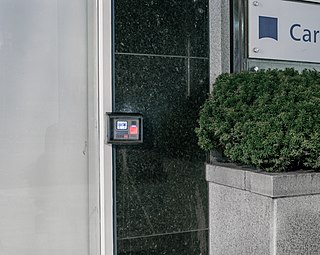
In the fields of physical security and information security, access control (AC) is the selective restriction of access to a place or other resource, while access management describes the process. The act of accessing may mean consuming, entering, or using. Permission to access a resource is called authorization.

Lock picking is the practice of unlocking a lock by manipulating the components of the lock device without the original key.

The Transportation Security Administration (TSA) is an agency of the U.S. Department of Homeland Security that has authority over the security of the traveling public in the United States. It was created as a response to the September 11 attacks under the administration of President George W. Bush, to improve airport security procedures and centralize air travel security under a single federal agency.

A warded lock is a type of lock that uses a set of obstructions, or wards, to prevent the lock from opening unless the correct key is inserted. The correct key has notches or slots corresponding to the obstructions in the lock, allowing it to rotate freely inside the lock.

The pin tumbler lock is a lock mechanism that uses pins of varying lengths to prevent the lock from opening without the correct key. Pin tumblers are most commonly employed in cylinder locks, but may also be found in tubular pin tumbler locks.
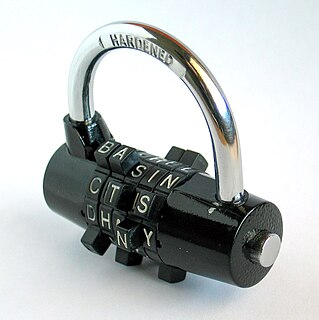
A combination lock is a type of locking device in which a sequence of symbols, usually numbers, is used to open the lock. The sequence may be entered using a single rotating dial which interacts with several discs or cams, by using a set of several rotating discs with inscribed symbols which directly interact with the locking mechanism, or through an electronic or mechanical keypad. Types range from inexpensive three-digit luggage locks to high-security safes. Unlike ordinary padlocks, combination locks do not use keys.

A lock is a mechanical or electronic fastening device that is released by a physical object, by supplying secret information, by a combination thereof, or it may only be able to be opened from one side, such as a door chain.

A lever tumbler lock is a type of lock that uses a set of levers to prevent the bolt from moving in the lock. In the simplest form of these, lifting the tumbler above a certain height will allow the bolt to slide past.

Baggage or luggage consists of bags, cases, and containers which hold a traveller's personal articles while the traveler is in transit. A modern traveller can be expected to have packages containing clothing, toiletries, small possessions, trip necessities. On the return trip, travelers may have souvenirs and gifts. For some people, luggage and the style thereof is representative of the owner's wealth and status. Luggage is constructed to protect the items during travel, either with a hard shell or a durable soft material. Luggage often has internal subdivisions or sections to aid in securing items. Handles are typically provided to facilitate carrying, and some luggage may have wheels and/or telescoping handles or leashes to make moving them easier.

Safe-cracking is the process of opening a safe without either the combination or the key.

The term hand luggage or cabin baggage refers to the type of luggage that passengers are allowed to carry along in the passenger compartment of a vehicle instead of a separate cargo compartment. Passengers are allowed to carry a limited number of smaller bags with them in the vehicle, which typically contain valuables and items needed during the journey. There is normally storage space provided for hand luggage, either under seating, or in overhead lockers. Trains usually have luggage racks above the seats and may also have luggage space between the backs of seats facing opposite directions, or in extra luggage racks, for example, at the ends of the carriage near the doors.

An electronic lock is a locking device which operates by means of electric current. Electric locks are sometimes stand-alone with an electronic control assembly mounted directly to the lock. Electric locks may be connected to an access control system, the advantages of which include: key control, where keys can be added and removed without re-keying the lock cylinder; fine access control, where time and place are factors; and transaction logging, where activity is recorded. Electronic locks can also be remotely monitored and controlled, both to lock and to unlock.
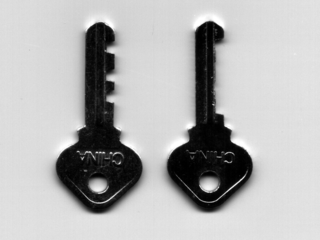
A skeleton key is a type of master key in which the serrated edge has been removed in such a way that it can open numerous locks, most commonly the warded lock. The term derives from the fact that the key has been reduced to its essential parts.
Rekeying a lock is replacing the old lock pins with new lock pins.
A master key operates a set of several locks. Usually, there is nothing special about the key itself, but rather the locks into which it will fit. These master-keyed locks are configured to operate with two, or more, different keys: one specific to each lock, which cannot operate any of the others in the set, and the master key, which operates all the locks in the set. Locks that have master keys have a second set of the mechanism used to operate them that is identical to all of the others in the set of locks. For example, master keyed pin tumbler locks often have two shear points at each pin position, one for the change key and one for the master key. A far more secure system has two cylinders in each lock, one for the change key and one for the master key.
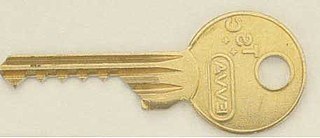
Lock bumping is a lock picking technique for opening a pin tumbler lock using a specially crafted bump key, rapping key or 999 key. A bump key must correspond to the target lock in order to function correctly.
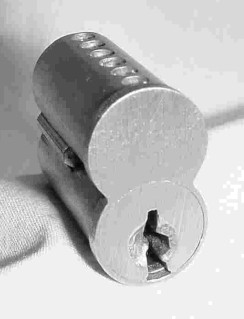
An interchangeable core or IC is an adaptable locking key cylinder. Unlike a standard key cylinder, which is accessible for combinating only via locking device disassembly, an interchangeable mechanism relies upon a specialized "control" key for insertion and extraction of the essential combinating components. "Small format" interchangeable cores are in a figure-eight shape that is standard among lock manufacturers. "Large format" interchangeable cores are of varying sizes. Interchangeable cores can be extracted from one lock type and then installed into another without requiring the removal or disassembly of any single component. These units are readily adapted for master keying systems and can be set up with spare cores and keys for quick replacement when security is compromised, such as when a key is lost or stolen or when a personnel change takes place. Extracted cores can then be recombinated without urgency and placed back into maintenance storage for future use.

Travel Sentry is a company that develops and licenses standards used in travel security, including a standard for luggage locks that can be opened by aviation security agencies such as the Transportation Security Administration (TSA).

Okoban is a system that allows individuals to register property with pre-assigned unique identification codes in an online database so that, if the property is lost then found, the finder can notify the registrant.
This is a glossary of locksmithing terms.


















